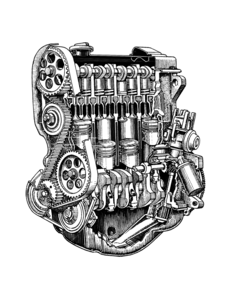TECH TIP: WHY DO BATTERIES GO BAD?
As a battery discharges during normal use, the cell plates take on sulfate from the acid solution. This lowers the concentration of the remaining sulfate in the acid while lowering the potential between the plates. As the battery runs down, the plates become saturated with sulfate, which makes them less able to continue the chemical reaction that generates current. Voltage and current output continue to drop and eventually the battery runs dead.
If not returned back into the solution by recharging, sulfate forms a barrier on the surface of the battery plates, which interferes with the battery's ability to make electricity. The gradual build-up of sulfate over time, which can be due to chronic undercharging (defective voltage regulator, weak alternator, slipping fan belt, insufficient driving time between starts to keep the battery fully recharged, etc.), eventually ruins the battery's ability to be fully recharged or to hold a charge. This usually occurs after four or five years of use or sooner, depending the circumstances.
Slow charging at 6 to 8 amps for up to 24 hours can sometimes restore a heavily sulfated battery.
When a battery is recharged, the chemical reaction is pushed backwards. A battery charger or alternator forces more voltage into the battery than it makes. This breaks the sulfate away from the cell plates and causes it to go back into the solution. As the battery becomes recharged, the specific gravity of the acid solution goes up. This can be checked on batteries that have removable caps with a hydrometer. Some sealed top batteries have a built in hydrometer that shows its state of charge (green means it's at least 75% charged; dark green means it's less than 75% charged, and clear or yellow means the water level is too low and the battery needs to be replaced.)
How long does it take to fully charge a battery? A lot longer than it takes to run one down. The amount of charging time depends on how run down the battery is and the condition of the battery and the charging rate. It can take anywhere from half an hour to eight hours or more to fully charge a battery. But one thing is for certain, it takes a lot longer to put amps back in to a battery than it does to take them out.
If an engine draws 225 amps to crank and it's cranked for two minutes, a charging system that puts out 75 amps can take up to half an hour to fully recharge the battery and that's under ideal circumstances. It takes a fair amount of driving between starts to keep a battery properly charged, especially in the winter when the lights, heater, wipers, rear window defogger and other accessories are all drawing juice from the system.
No surprises jump starting. Every winter you hear stories about people who try to do a good deed by jump starting another motorist's car and end up in the emergency ward because the battery blew up in their face. Despite their harmless appearance, batteries can be quite dangerous. They all give off hydrogen gas, even sealed top batteries. If you know anything about what happened to the Hindenburg airship, you know that all it takes is on little spark to make it go boom.
To minimize the danger of explosion, issue the three "NEVERS" to the DIY Customer: NEVER jump start a frozen battery or one that has a clear or yellow built in charge indicator and NEVER connect both jumper cables directly to both battery terminals. The positive jumper cable can be hooked up between both batteries, but the final negative jumper connections should be made to a good ground such as the engine block for frame on the vehicle with the discharged batter but, NEVER to the negative post on the discharge battery itself. This will keep any sparks away from the batteries.
Once the jumper cables are in place, the engine on the vehicle with good battery should be run at fast idle for a few minutes to charge up the weak battery. Then the attempt should be made to start the engine. This lessens the strain on the charging system and helps prevent the good battery from being drained.
If the engine refuses to start after 3 seconds of cranking, let it sit for another two minutes before trying again. If it won't start after three attempts the plugs are probably flooded and will have to be dried out before the engine will fire. This can be done by holding the pedal to the floor (prop the choke open if the engine has a carburetor) and cranking the engine. Pumping the pedal is a definite no-no because it puts more fuel into the engine.
If somebody doesn't pay attention to markings on both batteries and gets the jumper cables mixed up (positive to negative and vice versa), they'll likely be in need of a new alternator, voltage regulator and quite possibly an engine computer, some wiring and other electronics. Reversed battery connections create a runaway electrical circuit that makes short work of diodes and electronics.
WARNING: While our customers have found this information useful, these articles/links are not from technical publications. Information presented here is to give you a general idea of what to do and how to do it. Auto repair, while fun and economical, can be dangerous. There is no way we can warn you of each and every hazard. How can we tell you that when installing a hub cap, don’t smoke and have a bucket of gas nearby? If you have no common sense, ignore these articles. Otherwise, read the warnings in the front of the Robert Bentley manual before you proceeded to follow any advice given here.




